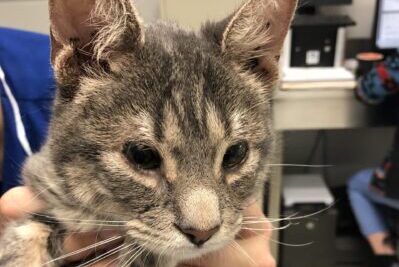Magnets, Toys and Dangerous Objects

Magnets, Toys and Dangerous Objects
One characteristic of pets that makes them so entertaining is their unpredictable nature. Some of them will eat anything — and when they do, the veterinarian is presented with a diagnostic challenge.
The veterinarian surgeons here at AMC have exceptionally good stories about the objects they have found jammed up inside of pets. Around the time of the first Toy Story, they removed an entire set of fast food plastic Toy Story characters from the stomach and intestines of a dog from a family with several small children. I remember a particularly challenging case where a cassette tape bunched up the intestines of a dog requiring a major surgical intervention to remove yards of Billy Joel’s “The Stranger.” Then there was the dog who had an entire kitchen knife lodged in his esophagus and lived to bark about it on the Jay Leno show.
X-rays are usually how veterinarians determine if a foreign object has been consumed and has resulted in an intestinal obstruction. Metallic objects like coins and knives, are easily seen with X-rays. Plastic and glass are not visible on X-rays and this is why the cassette tape and the plastic toys were particularly tough to diagnose.
Now, a new foreign body hazard has been reported in the May/June issue of the Journal of the American Animal Hospital Association — magnets. Ingestion of a single magnet is not likely to cause a problem. But ingestion of more than one magnet, or a magnet and another metal object, can cause serious problems. If these foreign bodies stick to each other through the intestinal walls of different intestinal segments, an obstruction can result. Even more serious is the potential for perforation. The pressure caused by two magnets, or a magnet and another metal foreign body sticking together, cuts off the blood supply to the intestine and the results can be deadly.
So a word to the wise, if your family has a precocious pup or a curious cat, keep small objects off the floor and provide plenty of safe toys to help prevent the inadvertent ingestion of dangerous objects.
This blog may also be found in the “Tales from the Pet Clinic” blog from WebMD.
_________________________________________________
For nearly a century, The Animal Medical Center has been a national leader in animal health care, known for its expertise, innovation and success in providing routine, specialty and emergency medical care for companion animals. Thanks in part to the enduring generosity of donors, The AMC is also known for its outstanding teaching, research and compassionate community funds. Please help us to continue these efforts. Send your contribution to: The Animal Medical Center, 510 East 62nd Street, New York, NY 10065. For more information, visit www.amcny.org. To make an appointment, please call 212.838.7053.


































